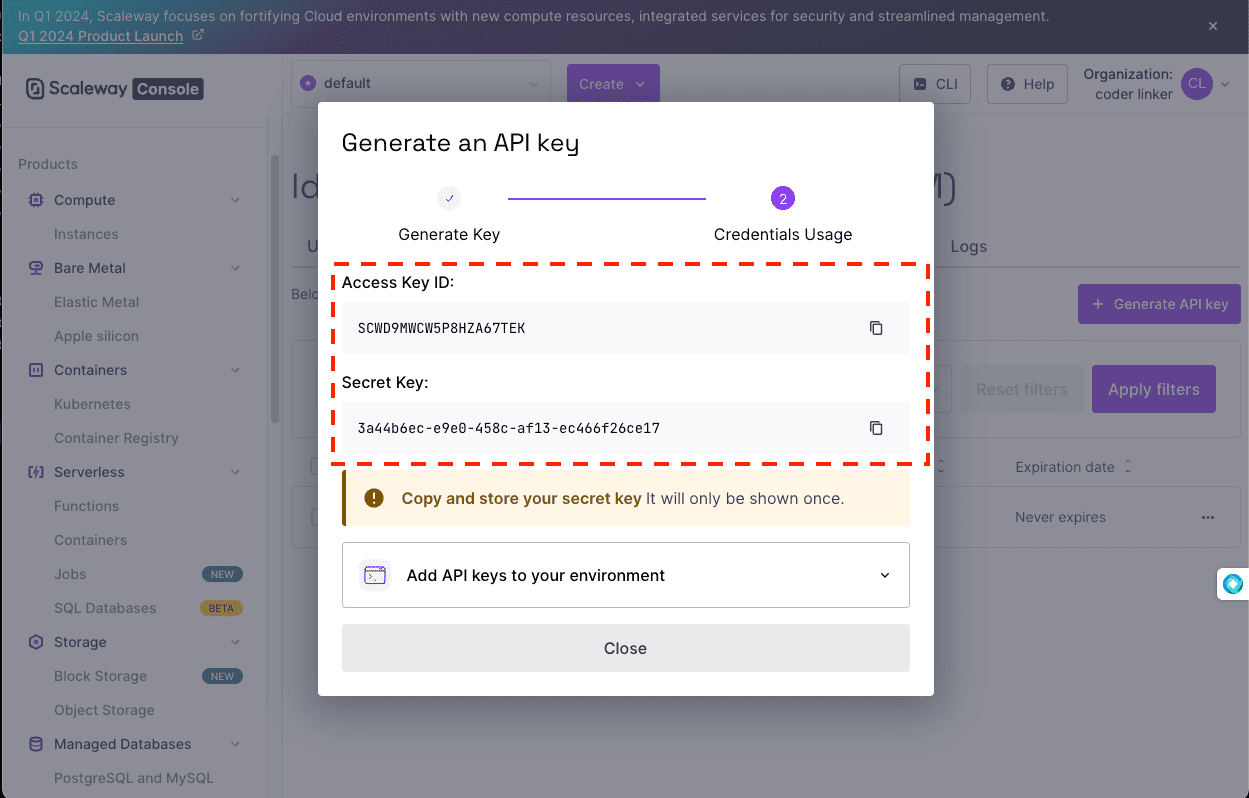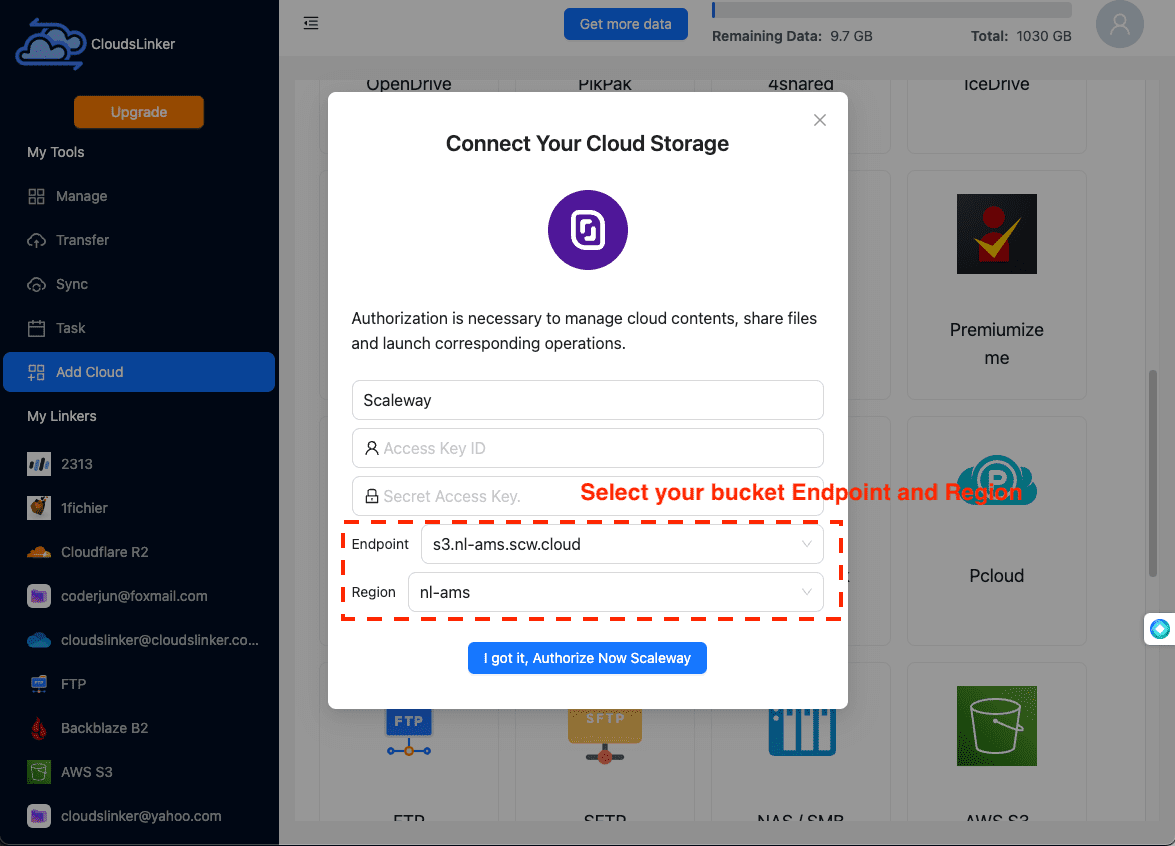Comparing Amazon S3 and Scaleway Object Storage: Which Is Best for You?
Dive into a thorough evaluation of Amazon S3 and Scaleway Object Storage, assessing their unique attributes and affordability to help you choose the most suitable cloud storage provider for your requirements.
Introduction
The competitive landscape of cloud storage services features Amazon S3 and Scaleway Object Storage as prominent contenders. This analysis delves into their distinct functionalities, pricing structures, and customer experiences to facilitate your decision on the optimal storage solution for your needs.
Navigating Cloud Storage Options
The cloud storage sector is rapidly expanding, offering sophisticated solutions like Amazon S3 and Scaleway Object Storage, each with their own advantages for managing and storing data. This segment highlights their unique features and cost models to help users make an educated selection.
The Evolution of Cloud Storage
Cloud storage has transformed global data management, with scalable options outpacing traditional storage methods. Amazon S3 and Scaleway Object Storage lead this shift, promoting enhanced accessibility and efficiency in operations.
Deciding Factors in Cloud Storage
Choosing the right cloud storage provider involves evaluating aspects like affordability, security, scalability, and compatibility. This guide offers a comparison between Amazon S3 and Scaleway Object Storage on these essential criteria.
Introduction to Amazon S3
About Amazon S3
Amazon S3 offers a robust, scalable, and secure environment for your data storage needs, supporting a wide range of scenarios from individual use to large-scale enterprise operations.
Amazon S3 Key Features
- Sophisticated lifecycle management for data.
- Enhanced security measures for comprehensive data protection.
- Extensive access control and seamless integration with other AWS offerings.
Amazon S3 Pricing
- Variable pricing models depending on data access and retrieval requirements.
- Economical options for long-term storage and data archiving.
Amazon S3 Use Cases
- Ideal for businesses requiring in-depth data analysis tools.
- Suitable for organizations seeking extensive cloud integration.
Discovering Scaleway Object Storage
Overview of Scaleway Object Storage
Scaleway Object Storage is recognized for its reliability and ease of use, providing a secure and efficient solution for managing large amounts of data. It features a straightforward, user-friendly interface that simplifies file management tasks.
Key Advantages and Features
- S3-compatible, ensuring seamless integration with existing tools and applications.
- High availability and multi-AZ resilience by design, safeguarding data against partial system failures.
- Offers multiple storage classes tailored to varying needs, including Standard and One Zone - Infrequent Access.
Scaleway Pricing Insights
- Competitive pricing model, praised for its cost-effectiveness and transparency.
Suggested Applications
- Ideal for cloud backups, large-scale data storage, and as an archival solution.
- Widely used for hosting media files for streaming, and for website content storage.
For further information, you can visit the official Scaleway Object Storage page.
Comparative Analysis: Amazon S3 vs Scaleway Object Storage
Performance and Reliability
Amazon S3 is renowned for its high performance, ensuring low latency and high throughput, capable of handling extensive datasets and millions of requests per minute. Scaleway Object Storage also maintains high performance with a robust infrastructure optimized for European connectivity, ensuring data availability even during outages.
Storage Class Options
S3 offers a range from frequently accessed data solutions to various long-term storage options at reduced costs, like the S3 Glacier for archival needs. Scaleway provides flexible and S3-compatible storage solutions, accommodating standard and cold data storage without egress fees, enhancing budget efficiency.
Cost-Effectiveness
Amazon S3 features intelligent tiering to optimize costs for fluctuating access patterns, while Scaleway is noted for its lack of egress fees, which significantly reduces costs for extensive data operations, particularly for clients with high outbound data.
Security and Compliance
Both platforms offer robust security measures; Amazon S3 provides comprehensive encryption and compliance capabilities. Scaleway ensures GDPR compliance, offering a secure choice for businesses managing or utilizing European data.
Integration and Scalability
Amazon S3 seamlessly integrates with other AWS services for enhanced functionality in analytics and ML projects. Scaleway boasts strong scalability with easy integration for existing architectures using S3-compatible tools, making it an excellent choice for expanding businesses.
| Feature | Amazon S3 | Scaleway Object Storage |
|---|---|---|
| Performance | High throughput, low latency | Optimized for European network |
| Storage Options | Multiple classes, including Glacier | Standard, cold storage without egress fees |
| Cost Management | Intelligent tiering for cost optimization | No egress fees, budget-friendly |
| Security | Advanced encryption, compliance supports | GDPR compliant, secure data handling |
| Scalability and Integration | Seamless AWS service integration | S3-compatible, easy scalability |
Efficiently Migrating Data: Amazon S3 to Scaleway Object Storage
Transitioning data between different cloud storage providers like Amazon S3 and Scaleway Object Storage requires a strategic and efficient approach. This section details the use of Python scripting to ensure a smooth migration process, leveraging the power of the boto3 library and Scaleway's API.
Using Python for Direct Data Transfer
Python's extensive library support provides a robust framework for migrating data from Amazon S3 to Scaleway Object Storage. Below is a basic Python script that uses boto3 for interacting with Amazon S3 and the requests library to handle operations with Scaleway.
Note: Ensure you have the necessary Python libraries installed and AWS and Scaleway API credentials configured before executing the script.
# Import necessary libraries
import boto3
import requests
# Initialize a session using your AWS credentials
session = boto3.Session(
aws_access_key_id='YOUR_AWS_ACCESS_KEY_ID',
aws_secret_access_key='YOUR_AWS_SECRET_ACCESS_KEY',
region_name='YOUR_AWS_REGION'
)
# S3 client using boto3
s3_client = session.client('s3')
# Scaleway Object Storage endpoint and headers
scaleway_endpoint = 'https://s3.fr-par.scw.cloud'
headers = {
'X-Auth-Token': 'YOUR_SCALEWAY_API_TOKEN'
}
# Specify the source bucket on S3 and the destination bucket on Scaleway
source_bucket = 'your-source-bucket-on-s3'
destination_bucket = 'your-destination-bucket-on-scaleway'
# List objects in the S3 bucket
response = s3_client.list_objects_v2(Bucket=source_bucket)
for obj in response.get('Contents', []):
key = obj['Key']
# Generate a presigned URL to download the object from S3
download_url = s3_client.generate_presigned_url('get_object',
Params={'Bucket': source_bucket, 'Key': key},
ExpiresIn=3600)
# Download the object from S3
file_content = requests.get(download_url).content
# Upload the object to Scaleway Object Storage
put_response = requests.put(f"{scaleway_endpoint}/{destination_bucket}/{key}",
data=file_content, headers=headers)
if put_response.status_code == 200:
print(f'Successfully transferred {key}')
else:
print(f'Failed to upload {key} to Scaleway Object Storage')
print('Migration process completed.')
Streamline Your Data Management with CloudsLinker
CloudsLinker enhances cloud storage management by supporting synchronization and data transfer across over 40 cloud storage and cloud drive platforms. Users can seamlessly sync or transfer data between popular services such as OneDrive, Dropbox, Mega, iDrive E2, Wasabi, Amazon S3, and Scaleway Object Storage, making it a versatile tool for managing extensive data arrays across diverse ecosystems.
Step 1: Initiating Setup
Begin your CloudsLinker experience by heading to its official website. Log in with an existing account or sign up to get started immediately. Access CloudsLinker’s main page by following this link: CloudsLinker's Website.
Step 2: Amazon S3 Configuration
Configuring Amazon S3 with CloudsLinker involves several critical steps to ensure seamless integration:
Step 2.1: Create an IAM User
Start by visiting the AWS Management Console. Under IAM, select Users and then ‘Create user’. This step is crucial for generating user credentials specifically for Amazon S3 access.

Step 2.2: Grant Access Permissions
Assign the necessary permissions by selecting ‘Attach policies directly’ and choosing AmazonS3FullAccess to ensure comprehensive access for the created user.

Step 2.3: Generate Access Keys
Within the IAM user settings, navigate to Security credentials and create new access keys. These keys are pivotal for third-party service integration.

Step 2.4: CloudsLinker Integration
With the access keys generated, proceed to CloudsLinker and under ‘Add Cloud’, select Amazon S3. Input the Access Key and Secret Access Key to complete the setup.

Step 3: Integrating Scaleway Object Storage
Integrating Scaleway Object Storage with CloudsLinker involves several key configurations:
Step 3.1: Generate API Credentials
First, log into your Scaleway console to create and retrieve your API credentials. These credentials are essential for allowing CloudsLinker to interact with your Scaleway storage.

Step 3.2: Access Key ID
Access Key ID: Provided by Scaleway when you generate your API credentials. This key will be used to identify your Scaleway account in API requests.
Step 3.3: Secret Access Key
Secret Access Key: Also provided by Scaleway, used in conjunction with the Access Key ID to securely authenticate API requests.
Step 3.4: Endpoint Configuration
Endpoint: Configure the specific URL that CloudsLinker will use to connect to your Scaleway Object Storage, typically formatted as https://s3.fr-par.scw.cloud.

Step 3.5: CloudsLinker Integration
With the API credentials set, proceed to CloudsLinker and under ‘Add Cloud’, select Scaleway Object Storage. Input the Access Key ID, Secret Access Key, and Endpoint to complete the setup.

Step 4: Managing Data Transfers
Orchestrate your data transfers by selecting Amazon S3 as the source and Scaleway Object Storage as the destination. CloudsLinker streamlines these processes, supporting large file handling and enabling a broad range of storage options. Additionally, you can choose between transfer and synchronization modes. In synchronization mode, CloudsLinker ensures that the data in the target location mirrors that in the source location, automatically removing any files in the destination that are no longer present in the source to maintain consistency.

Conclusion: Verify and Optimize Your Setup
Upon completing the migration, utilize CloudsLinker's comprehensive monitoring tools to confirm the integrity of the transferred data and fine-tune your configuration to enhance future data transfers. This ensures a reliable and streamlined data management strategy.

Advanced Data Migration: Comparing Traditional Methods and CloudsLinker
Understanding Migration Dynamics
When migrating data between Amazon S3 and Scaleway Object Storage, traditional methods often involve complex setups or direct use of scripts that require robust programming knowledge and local resource utilization. In contrast, CloudsLinker offers a streamlined, cloud-based solution that simplifies this process.
CloudsLinker: A Superior Approach
CloudsLinker revolutionizes data migration by executing all operations in the cloud, thus eliminating the need for local execution and zero local data traffic, which conserves bandwidth and reduces operational costs. Unlike traditional methods that can be slow and resource-intensive, CloudsLinker facilitates faster data transfers by leveraging optimal routing and server-side processing.
Additionally, CloudsLinker supports both transfer and synchronization modes. In synchronization mode, it ensures that the destination data is a mirror image of the source, automatically deleting any files in the destination that are not present in the source. This mode is particularly beneficial for maintaining consistency across storage platforms without manual intervention.
Comparative Analysis
| Feature | Traditional Methods | CloudsLinker |
|---|---|---|
| Execution Method | Local or server-based, requiring setup and maintenance. | Fully cloud-based, no local setup required. |
| Data Traffic | Consumes local bandwidth, higher costs. | Zero local traffic, reduces costs significantly. |
| Speed | Dependent on local infrastructure and internet speed. | Optimized server-side processing for maximum speed. |
| Maintenance | Requires ongoing maintenance and monitoring. | Minimal maintenance, CloudsLinker handles all backend operations. |
| Synchronization | Often manual, prone to errors and inconsistencies. | Automatic, ensures data consistency and integrity. |
This comprehensive comparison highlights CloudsLinker's ability to offer a more efficient, cost-effective, and user-friendly solution for data management and migration needs across various cloud storage platforms.
Frequently Asked Questions (FAQs)
Conclusion
The decision to opt for Amazon S3 or Scaleway Object Storage hinges on several critical considerations including budget constraints, system performance, and required storage features. Each platform offers unique benefits suited to various industry needs and operational scales. A meticulous comparison of their characteristics will guide you in selecting the storage service that best matches your goals.
Online Storage Services Supported by CloudsLinker
Transfer data between over 44 cloud services with CloudsLinker
Didn' t find your cloud service? Be free to contact: [email protected]
Further Reading
Effortless FTP connect to google drive: Transfer Files in 3 Easy Ways
Learn More >
Google Photos to OneDrive: 3 Innovative Transfer Strategies
Learn More >
Google Photos to Proton Drive: 3 Effective Transfer Techniques
Learn More >











































